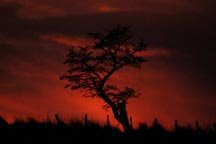
Sunset photographs have always been extremely popular. Not only are they beautiful, but they also have an almost magical ability to bring back fond memories of your tropical vacation.
Most beginning photographers incorrectly believe that capturing one of these colorful beauties is beyond their ability.
However, anyone can photograph a sunset and produce at least a relatively good result.
However, if you want to photograph sunsets that stop people in their tracks, you're in the right place. But to go from "that's nice" to "WOW", we need to cover a few things.The Right Conditions for Sunset Pictures
You need 2 environmental conditions in order to have a chance capturing a stunning sunset:
DUST and CLOUD in air
The red-orange of the setting sun results from dust (or other microscopic particles) in the air. Dust comes from everywhere: the ground, smoke, industrial pollution... to name a few.
Clouds also add a critical factor. Thick clouds or wispy ones - it doesn't matter. Each will provide a unique effect. Don't get me wrong. I've taken plenty of sunset pictures on cloudless evenings without any dust in the air. But, they all result in fairly bland photos. Don't Center the Horizon on Sunset Pictures
The worst thing you can do with sunset pictures is to compose the shot so that the horizon is in the center of the picture.As a general rule, the more beautiful the sky, the more of it you want to show. The more interesting the foreground, the more of it you want to show.
Of course, you want to use good rules of composition and common sense. Bottom line, if the horizon is approximately at the top or bottom one third of the frame, your sunset pictures will be more appealing.Composition
Your sunset photos will be significantly improved when you include a foreground object(s) silhouetted against the background sky.

Make sure your camera is set to the "no flash" option. (See the following section on exposure.)
The most common foreground objects when photographing sunsets are people, trees, or unusual objects (or, normal objects seen differently).
However, let your creativity out and you will be pleasantly surprised at what you come up with.
Even the most spectacular sunset will look like abstract wallpaper if you don't provide some context. Silhouetted trees or other objects in the foreground give a sense of scale and location to the scene. A stunning sunset will have a different feeling if it's taken at the beach with a few palm trees in the foreground.
The Right Exposure for Sunset Pictures
Without question, the most challenging part of taking sunset photos involves what exposure to use. Here's the bad news: there is no one right answer.And, for the good news ... several different exposures will produce excellent (but different) results.
... several different exposures will produce excellent (but different) results.
Nowhere else in photography does the suggestion to experiment hold more weight, than when photographing sunset pictures. Using your camera's built-in metering mode will often result in the sky registering as relatively bright, and therefore will underexpose the entire image.
As you recall, when any given image has a huge range between light and dark, achieving the optimum exposure is a challenge.
If matrix metering is used, everything is averaged with the likely result being a darker-than-desired sunset picture. One way to handle this is with a light meter (or flash meter) depending on your overall use.
There are two approaches to get around this issue. The first approach is called bracketing the shot. Bracketing is used to get the best exposure, by gong through an educated trial and error.
To accomplish bracketing, you either need to be able to manually set the aperture and exposure time, or your camera needs to have a bracketing function (available on most digital SLRs).
For whatever metering mode you're using, your camera indicates the correct exposure for a particular photograph.
Let's say it is 1/60 of a second at f/8.
The first thing to do, is take the picture exactly according to your camera's recommendations.
Next, manually change the f-stop to f/5.6 (one stop more exposure) while keeping the exposure time at 1/60th of a second. Then, take another shot using f/11 (one stop less exposure).
If your sunset picture has the potential of true greatness, I would suggest taking additional shots at different exposure combinations.
Chances are good that although each image will be lighter or darker than its companion picture, you will find at least one that hits the mark. The two sunset pictures below are almost identical, except for the bracket differences. As you can see, a one stop difference on exposure can make a big difference in the final image.
 | |

This is what you do... First, point your camera at a bright part of the sky (not directly at the sun), activate the auto exposure lock, recompose the entire sunset picture and take the shot. Next, point your camera at the darkest part of the scene, lock in the auto exposure, recompose and take the shot.
Every time you meter against a different part of the scene and lock in the exposure for that section; your overall recomposed image will come out slightly different.
Be creative. Try what you think won't work. You may create a truly spectacular result.
If you haven't tried shooting sunrises or sunsets before, you'll be impressed with the results and the effects that more or less exposure can have on the final image.
Experiment. There is no "right" exposure. Since many exposures will be over 1 - 2 seconds, use a remote release or shutter release cable for your camera, and a tripod for stability.
Timing
Sunsets are not static. They change over time. When you prepare to take sunset pictures, plan to spend at least 45 minutes to choose the perfect location, set up your equipment, and take your readings.
It's a good idea to photograph the scene every few minutes or so. Clouds move, colors deepen and change, and the image you record a 15 minutes later may have more drama and richer colors than you saw earlier. This is definitely the time you want to take lots and lots of pictures. When you check the results on your computer, delete the "also-rans."













No comments:
Post a Comment